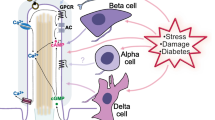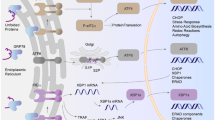Summary
Microperfusion experiments were performed in rats to assess the effect of luminal application of theophylline and the more lipophilic 3-isobutyl-1-methylxanthine (IBMX) on feedback regulation of glomerular filtration rate. Elevation of loop of Henle flow from 0 to 40 nl/min caused a 20.3±4.5% reduction of stop flow pressure (SFP) and a 32.2±3.7% reduction of early proximal flow rate (EPFR) when the perfusate was a 140 mM NaCl solution. When theophylline was added in a concentration of 5 mM SFP fell by only 5.3±1.8% and EPFR by 7.9±3.3%, changes which were significantly smaller than in the control perfusions (P<0.01). An identical change of loop of Henle flow in the presence of IBMX in concentrations of 1 and 5 mM was associated with a 4.5±3.9% decrease and a 12.1±2.7% increase of EPFR. In orthograde perfusion experiments full inhibition of the feedback response was noted at an IBMX concentration of about 1 mM while during retrograde perfusion a concentration of 0.4 mM was sufficient to produce the same effect. This indicates that methylxanthines diffuse out of the loop of Henle to a considerable extent. Methylxanthines reduced absolute and fractional water absorption along the loop of Henle to some extent while Cl absorption rates and early distal Cl concentrations were not significantly altered. Cyclic AMP applied from the luminal side in a concentration of 10 mM did not affect the feedback response of EPFR to flow elevation from 0 to 40 nl/min. Luminal application of dibutyryl cyclic AMP at 10 mM induced a small, but significant reduction of the feedback response when tested by pairedt-test (P<0.05). Our results show that luminal application of methylxanthines strongly interfere with feedback regulation of glomerular filtration rate. It is unclear at present whether this effect is related to inhibition of cyclic nucleotide phosphodiesterase and a rise in tissue cyclic AMP levels or to interference with a mechanism involving the local action of adenosine or 5′-AMP.
Similar content being viewed by others
References
Afonso, S.: Inhibition of coronary vasodilation action of dipyridamole and adenosine by aminophylline in the dog. Circulat. Res.26, 743 (1970)
Andersson, R.: Cyclic AMP as a mediator of the relaxing action of papaverine, nitroglycerin, diazoxide, and hydralazine in intestinal and vascular smooth muscle. Acta pharmacol. (Kbh.)32, 321 (1973)
Beavo, J. A., Rogers, N. L., Crofford, O. B., Baird, C. E., Hardman, J. G., Sutherland, E. W., Newman, E. V.: Effects of phosphodiesterase inhibitors on cyclic AMP levels and lipolysis. In: Cyclic AMP and cell function. Ann. N.Y. Acad. Sci.185, 129 (1971)
Bünger, R., Haddy, F. J., Gerlach, E.: Coronary responses to dilating substances and competitive inhibition by theophylline in the isolated perfused guinea pig heart. Pflügers Arch.358, 213 (1975)
Ebert, R., Schwabe, W.: Studies on the antilipolytic effect of adenosine and related compounds in isolated fat cells. Naunyn-Schmiedeberg's Arch. Pharmacol.278, 247 (1973)
Greven, J., Fülgraff, G.: Probleme bei der Bestimmung der prozentualen Resorption aus Halbwertszeit und Passagezeit von proximalen Tubuli von Rattennieren. Pflügers Arch.315, 38 (1970)
Grupp, G.: Über den Einfluß von Narcotica und vasokonstriktorisch wirkenden Pharmaka auf die Autoregulation der Nierendurchblutung. Naunyn-Schmiedebergs Arch. exp. Path. Pharmak.235, 261 (1959)
Hashimoto, K., Kumakura, S.: The pharmacological features of the coronary, renal, mesenteric, and femoral arteries. Jap. J. Physiol.15, 540 (1965)
Knox, F. G., Ott, C., Cuche, J. L., Gasser, J., Haas, J.: Autoregulation of single nephron filtration rate in the presence and the absence of flow to the macula densa. Circulat. Res.34, 836 (1974)
Lugnier, C., Bertrand, Y., Stoclet, J. C.: Cyclic nucleotide phosphodiesterase inhibition and vascular smooth muscle relaxation. Europ. J. Pharmacol.19, 134 (1972)
Maddox, D. A., Troy, J. L., Brenner, B. M.: Autoregulation of filtration rate in the absence of macula densa-glomerulus feedback. Amer. J. Physiol.227, 123 (1974)
Mah, H. D., Daly, J. W.: Adenosine-dependent formation of cyclic AMP in brain slices. Pharmacol. Res. Commun.8, 65 (1976)
Mitenko, P. A., Ogilvie, R. L.: Pharmacokinetics of intravenous theophylline. Clin. Pharmacol. Ther.14, 509 (1973)
Navar, L. G., Burke, T. J., Robinson, R. R., Clapp, J. R.: Distal tubular feedback in the autoregulation of single nephron filtration rate. J. clin. Invest.53, 516 (1974)
Ono, H., Inagaki, K., Hashimoto, K.: A pharmacological approach to the nature of the autoregulation of the renal blood flow. Jap. J. Physiol.16, 625 (1966)
Osswald, H.: Inhibition and restoration of autoregulation of renal blood flow by theophylline and adenosine. Pflügers Arch.279, R9 (1973)
Osswald, H.: Renal effects of adenosine and their inhibition by theophylline. Naunyn-Schmiedeberg's Arch. Pharmacol.288, 79 (1975)
Osswald, H., Schmitz, H.-J., Heidenreich, O.: Adenosine response of the rat kidney after saline loading, sodium restriction, and hemorrhagia. Pflügers Arch.357, 323 (1975)
Osswald, H., Kemper, R., Schmitz, H.-J.: Effects of adenosine on renal function and its inhibition by theophylline in sodium restricted and DOCA-treated rats. Naunyn-Schmiedeberg's Arch. Pharmacol.293, R37 (1976)
Osswald, H., Schmitz, H.-J., Kemper, R.: Tissue concentration of adenosine, inosine, and hypoxanthine in the rat kidney after ischemia and postischemic recirculation. Pflügers Arch.362, R10 (1976)
Ploth, D. W., Schnermann, J.: Dependency of autoregulation of nephron filtration rate on maintenance of distal fluid delivery. VIth Int. Congr. Nephrol., Abstracts of Free Communications, Firenze 1975
Ramsay, J. A., Brown, R. H. J., Croghan, P. C.: Electrometric titration of chloride in small volumes. J. exp. Biol.32, 822 (1955)
Sattin, A., Rah, T. W.: The effect of adenosine and adenine nucleotides on the cyclic adenosine 3′:5′ phosphate content of guinea pig cerebral cortex slices. Molec. Pharmacol6, 13 (1970)
Schaumann, W., Juhrau, W., Dietmann, K.: Antagonismus der Kreislaufwirkungen von Adenosin durch Theophyllin. Arzneimittel-Forsch.20, 372 (1970)
Schnermann, J., Wright, F. S., Davis, J. M., v. Stackelberg, W., Grill, G.: Regulation of superficial nephron filtration rate by tubuloglomerular feedback. Pflügers Arch.318, 147 (1970)
Schnermann, J., Hermle, M., Schmidmeier, E., Dahlheim, H.: Impaired potency for feedback regulation of glomerular filtration rate in DOCA escaped rats. Pflügers Arch.358, 325 (1975)
Schnermann, J., Hermle, M.: Maintenance of feedback regulation of filtration dynamics in the absence of divalent cations in the lumen of the distal tubule. Pflügers Arch.358, 311 (1975)
Thurau, K.: Renal hemodynamics. Amer. J. Med.36, 698 (1964)
Triner, L., Nahas, G. G., Vulliemoz, Y., Overweg, N. I. A., Verosky, M., Habif, D. B., Ngai, S. H.: Cyclic AMP and smooth muscle function. In: Cyclic AMP and cell function, Ann. N.Y. Acad. Sci.185, 458 (1971)
Wright, F. S., Schnermann, J.: Interference with feedback control of glomerular filtration rate by furosemide, triflocin, and cyanide. J. clin. Invest.53, 1695 (1974)
Author information
Authors and Affiliations
Additional information
Supported by the Deutsche Forschungsgemeinschaft
Rights and permissions
About this article
Cite this article
Schnermann, J., Osswald, H. & Hermle, M. Inhibitory effect of methylxanthines on feedback control of glomerular filtration rate in the rat kidney. Pflugers Arch. 369, 39–48 (1977). https://doi.org/10.1007/BF00580808
Received:
Issue Date:
DOI: https://doi.org/10.1007/BF00580808




